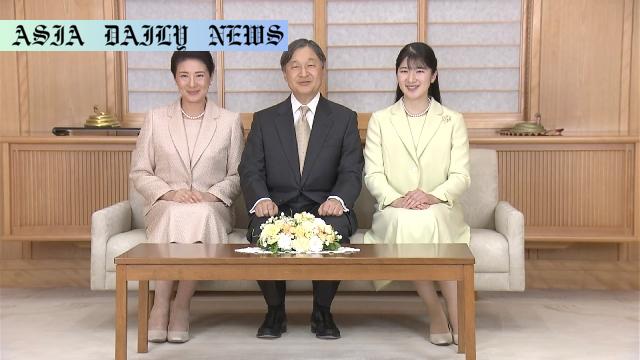Okinawa – Japan’s Emperor Naruhito, Empress Masako, and Princess Aiko will honor WWII victims on a meaningful visit next month.
- Japan’s Imperial family to visit Okinawa for WWII commemoration.
- Emperor Naruhito’s first visit in over two years; Princess Aiko’s debut.
- The visit includes tributes at Itoman cemetery and peace museums.
- Tribute paid to 1944 Tsushima Maru tragedy and Shuri Castle restoration.

Japan’s Commitment to Remember: The Historical Context
In an act of recognition, reconciliation, and reflection, Japan’s Imperial Family—Emperor Naruhito, Empress Masako, and their daughter, Princess Aiko—are set to visit Okinawa early next month. This visit marks the commemoration of one of Japan’s most devastating historical events: the 80th anniversary of the Battle of Okinawa during World War II. The battle, which occurred in 1945, left a scar not only on Okinawa’s landscapes but also on the collective memory of the people. With over 200,000 lives lost, many civilians, including schoolchildren, remain etched in painful memories. The visit, scheduled for June 4, carries immense historical and emotional weight—making it the couple’s first return in over two years, while being Princess Aiko’s first visit. This unique and rare occurrence is highly anticipated and carries broader significance for Japan’s historical consciousness and healing.
Honoring the Lives Lost at Key Historical Sites
The Imperial Family will visit some of Okinawa’s most significant landmarks, beginning their journey at Itoman City’s national cemetery. This solemn space serves as the final resting place for over 180,000 victims of this gruesome battle, which included countless civilians, local residents, and soldiers. Choosing to pay their respects here underscores the family’s dedication to honoring every victim regardless of their background or military affiliation. Their visit also includes the Cornerstone of Peace—a memorial where the names of all the individuals who perished are engraved. These gestures highlight the importance of historical acknowledgment and stand as a reminder of the value of peace. Alongside survivors of the Battle of Okinawa, the family will hear firsthand accounts, connecting them deeply with the human aspect of history’s tragedy.
Rekindling Historical Understanding Through Museums
The second day of their Okinawan visit centers on museums dedicated to preserving the histories of wartime devastation and postwar recovery. Among the highlights of this journey is the visit to a memorial museum in Naha City, where the tragedy of the Tsushima Maru is elaborately chronicled. The vessel’s sinking by US forces while evacuating civilians from Okinawa to Kyushu in 1944 resulted in nearly 1,500 casualties, including 780 school children. This museum captures a lesser-known but deeply heartbreaking chapter in WWII history and reminds the visitors of Okinawan sacrifices. Additionally, their itinerary includes the Ocean Expo 1975 exhibition commemorating its 50th anniversary, celebrating Okinawa’s reversion to Japan after US administration. The confluence of sorrow and celebration emphasizes Okinawa’s persistent journey toward healing and culture preservation.
Shuri Castle: A Symbol of Reconstruction
The final stop on the royal agenda showcases Shuri Castle, a vital cultural touchstone and Okinawa’s unmistakable landmark. Tragically destroyed in a fire six years ago, the castle is being restored to its former glory—a process revered by locals and watched closely across Japan. For the Imperial Family, visiting this site represents an acknowledgment of Okinawan resilience. It also stands as a symbol of nationhood and historical preservation. By witnessing the reconstruction, the family highlights the importance of embracing cultural heritage while propelling the region toward continued recovery and revitalization.
Moving Forward with Memory and History
This two-day trip transcends mere protocol; it emanates a profound commitment to learning from the past while promoting reconciliation and unity for the future. The Okinawa visit showcases not only a recognition of history’s heavier burden but also the aspiration to reconnect contemporary Japan with the lessons of its past. It aligns poignantly with Emperor Naruhito’s commitment to peace, global understanding, and acknowledgment of the truth.



Commentary
The Significance of Commemorative Actions like This
Emperor Naruhito, Empress Masako, and Princess Aiko’s visit to Okinawa goes far beyond ritualistic formalities. This carefully crafted itinerary holds a beacon of hope for historical reflection, reconciliation, and acknowledgment. The Imperial Family is not merely visiting memorials and museums; they are embodying Japan’s deeper efforts to engage with its past while echoing themes of pacifism and remembrance. This is particularly important in an era where the memories of World War II seem distant to younger generations. Amid socio-political challenges and Japan’s evolving role in global geopolitics, gestures like this ensure that the lessons of the past remain significant in Japan’s contemporary narrative.
Why Okinawa Holds a Unique Place in History
Okinawa represents resilience. From WWII tragedies to the struggles surrounding US military bases on its soil, the prefecture has endured historical hardships unique to its geographic and political positioning. The dissolution between Okinawa as a wartime battleground and its identity as a modern Japanese prefecture cannot be underestimated. This visit brings much-needed national attention to Okinawa’s storied past and will likely spark renewed discussions in classrooms, community networks, and national platforms highlighting the prefecture’s invaluable contributions to Japan.
The Emotional Weight of the Royal Visit
Princess Aiko joining this trip is a significant development. As newer members of the Imperial Family progressively step into public roles and ceremonies, her debut visit serves as the passing of the torch in terms of fostering cultural and historical awareness across generations. The first-hand encounters with survivors not only leave lasting imprints but also solidify her understanding of Pacific history, which will likely shape her outlook and future narratives. This journey, steeped in emotion and symbolism, is a poignant reminder of the enduring power of remembrance. It reinforces the essentiality of preserving peace and the collective responsibility of ensuring such tragedies are never repeated.